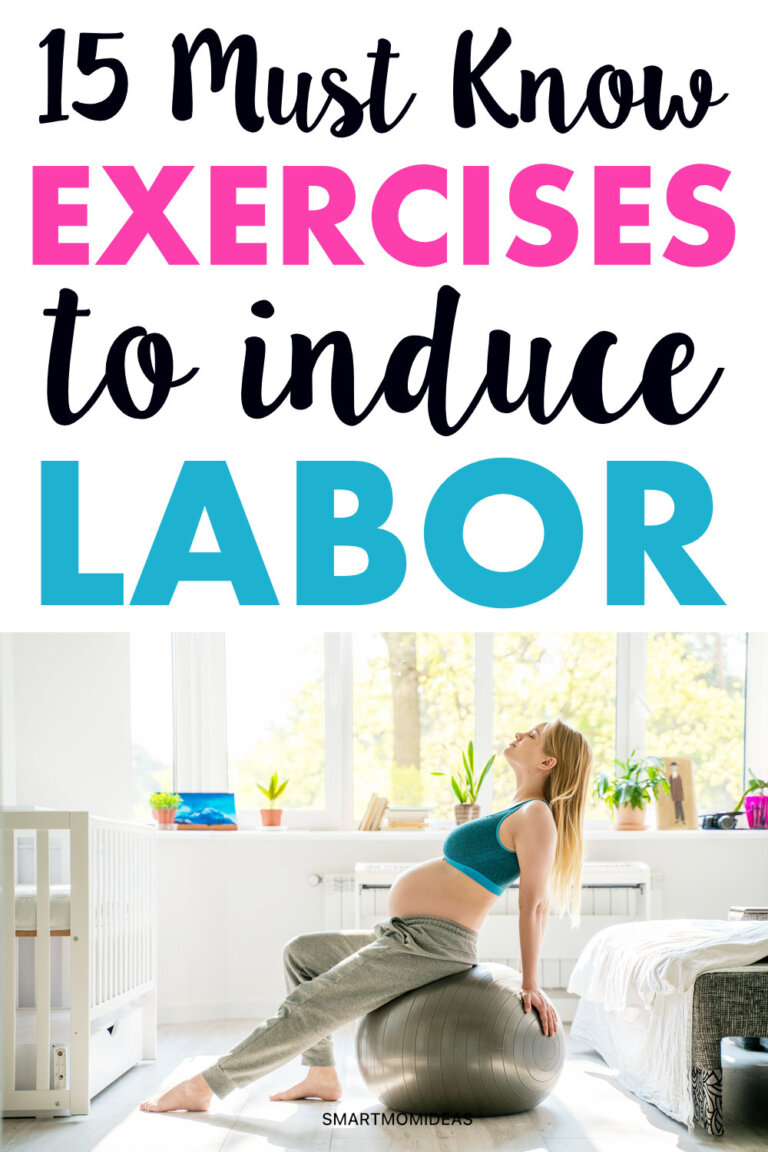Get this great list of exercises to induce labor!
The time has come!

It’s your due date and…nothing.
Your baby isn’t making a move and, by the time you reach your third trimester, you are probably anxious to get the party started.
Realize though, babies don’t always work on a schedule, and if your due date comes and goes with no signs of labor, you may want to try inducing labor yourself.
What?
You can work on inducing labor yourself?
Yup! You can.
There are certain movements and exercises you can do to improve your body’s alignment and position your baby for delivery.
When I was heading to the end of my pregnancy with my twins, not only was I excited to meet them but I was looking forward to having my pre-pregnancy body back!
I can imagine you feel the same way if you are looking for safe ways to induce labor.
But, before I get into these exercises, let’s first talk about whether or not inducing labor with exercise is safe and when you should start doing these exercises
Is It Safe to Induce Labor With Exercise?
Performing exercises to induce labor is perfectly safe for low-risk pregnant women.
However, you should absolutely discontinue doing these exercises if you experience abdominal pain, vaginal bleeding, amniotic fluid leakage, and regular painful contractions.
The same goes for dizziness, headaches, chest pain, muscle weakness, loss of balance, and shortness of breath!
Ultimately, you should always speak with your healthcare practitioner if you plan to do exercises to induce labor, especially if you do have a high-risk pregnancy.
But if you’re wondering how to start labor with exercise, here are a few you can try!
Start slow and don’t push yourself beyond your abilities.
When Can I Start Doing Exercises to Induce Labor?
Starting these exercises early in your pregnancy isn’t going to result in premature birth.
In fact, doing these exercises is a great way to strengthen your body and prepare it for childbirth.
To be honest, there are no guaranteed ways to induce labor but these exercises can certainly help get things moving when your body is starting to gear up for the big moment!
So if it’s about time for your baby to start heading down, these movements can gently encourage her or him to do so.
Ready to check them out?
How to Start Labor: Try These Exercises!
There are a few things you can do to try and bring on labor, but before trying any of them, it’s important to check with your doctor or midwife first.
Once you get the go-ahead, here are some of the best exercises to induce labor.
1. Birthing Ball
Birthing balls are basically large exercise balls you can use to bring on labor.
When you sit on a birthing ball in a wide-legged position, you increase blood flow, open your pelvis, and encourage your cervix to dilate naturally.
If you’re wondering how to dilate faster using a birthing ball, try gently rotating your hips while sitting on the ball or gently bouncing up and down.
Best all-around birthing/exercise/yoga ball: Mind Body Future Exercise Ball for Pregnancy
2. Pelvic Tilts
When you are in the midst of delivery, your pelvic bones separate in order to accommodate your baby’s head.
You can keep these joints loose and ready for labor by doing pelvic tilt exercises.
Start by laying on your back and bending your knees so your feet are flat against the floor.
Slowly lift your pelvis until it’s parallel with your midsection.
Hold it here for about 10 seconds and then gently return to your starting position.
3. Lunges
Doing lunges will help stretch your hips and open your pelvis.
This is a great move to encourage your baby to move into an ideal birthing position.
Standing up straight, take a big step forward with one leg and keep your knee over your ankle.
Drop your other leg so it’s parallel to the floor.
If you need to, have a chair handy to hang onto so you don’t lose your balance!
4. Butterfly Pose
The butterfly pose can help increase your pelvic joints’ flexibility as well as improve blood flow and induce labor.
Sitting upright on the floor, bend your knees and bring the soles of your feet together.
Pull your feet toward your body until you feel your hips and inner thighs stretching.
You can use your elbows to gently push down on your knees but don’t do this to the point of feeling pain!
5. The Miles Circuit
The creator of the Miles Circuit took a few ways to induce labor, put them together, and named them after her friend!
The Miles Circuit has three steps that help your baby get into an optimal birthing position.
The complete circuit takes about 90 minutes and uses both movement and relaxation to induce labor.
The exercises include open knee chest movements, a side-lying position, and 30 minutes of movement.
6. Forward Bend
Forward bends can help your body make space in your pelvis and encourage your baby to get moving!
Using something sturdy you can hold on to, like a wall or counter, stand with your legs parallel and hip-width apart.
Bend forward and stick your butt out, moving your hips from side to side.
7. Walk

There’s a reason pregnant women are stereotypically depicted as walking up and down hospital corridors.
Walking helps with cervical dilation and encourages the baby to drop into the pelvic area.
Walking should be a part of your regular exercise routine during your pregnancy but it can definitely help if you’re wondering how to dilate faster.
8. Squats
Other than strengthening your bum and leg muscles, squats are a great way to induce labor!
They stretch the pelvic floor and encourage your baby to head on down.
Once your baby is in a head-down position, try squatting for 5 minutes each day by leaning against a wall, placing your feet shoulder-width apart, and bending your knees as low as you can.
You can even use an exercise ball behind your back to make this move more comfortable!
9. Dance It Out
No, shaking your hips to Shakira isn’t necessarily going to encourage labor, but slow dancing can!
Out of all the exercises to induce labor, this very well may be the most enjoyable.
Place your arms around your partner’s neck (this can be any support person in your life!) and lean on them.
Relax and sway your hips from side to side.
This movement invites your pelvis to open and, by connecting with someone you love, your body will release oxytocin which is a natural hormone that causes the uterus to contract!
10. Climbing Stairs
By walking up and down some stairs while naturally angling your body at around 40-45 degrees, this exercise will encourage your baby to head to your pelvis.
If you can manage to skip steps, this helps to open the pelvis even more and can cause your cervix to thin and dilate more quickly.
11. Get It On
Having sex can actually stimulate labor! Not only do orgasms release oxytocin but they release prostaglandins which is another natural hormone that softens the cervix and can help you dilate faster.
Fun fact: Prostaglandins are found in semen as well.
Just keep in mind that if your water has already broken, doing the deed to induce labor is a no-go.
Doing so can increase your risk of infection.
12. Cat and Cow Yoga Poses
Cat-Cow is probably one of the easiest yoga poses and a great way to shift your baby away from your spine and toward the birth canal.
In fact, cat and cow yoga poses can be used to try and turn a breech baby (as long as it’s recommended by your healthcare provider).
This yoga move has some other birthing benefits too!
It will help lengthen your spine, relieve discomfort, and help your chest and lungs open for easier breathing.
13. Kegels
Kegel exercises are super effective for strengthening your pelvic floor.
While doing them may not help induce labor, having strong pelvic floor muscles is going to make the world of difference during delivery!
Doing Kegels will help you learn how to control your muscles during labor so you can more effectively push.
Plus, following childbirth, strong pelvic muscles will help prevent using such as abdominal discomfort and incontinence.
14. Swimming

If you enjoy swimming, you can definitely swim right up until the day you go into labor (unless your doctor has said otherwise).
Doing exercises to induce labor in water is a great way to take pressure off your joints and swimming itself stimulates the muscles in your lower body which can help start labor as well.
15. Acupuncture
For pregnant women who are ready to meet their baby, but still waiting for labor to start, acupuncture may be a helpful way to induce labor.
Acupuncture is a form of traditional Chinese medicine that involves inserting thin needles into specific points on the body.
This can help to stimulate contractions and bring on labor.
While there is no guarantee that acupuncture will work for everyone, it is a relatively safe and low-risk option for those who want to avoid more medical interventions.
If you’re considering using acupuncture to induce labor, be sure to consult with your healthcare provider first.
FAQ’s on Using Exercises to Induce Labor
1. What are the First Signs of Labour?
The first signs of labor are usually a loss of the mucus plug followed by bloody show.
You may also experience contractions, which can be painless at first but tend to become more intense as labor progresses.
Other early signs of labor include nesting (a sudden urge to clean and prepare your home for baby) and lightening (when baby drops down into your pelvis).
If you experience any of these signs, it’s a good idea to contact your doctor or midwife for advice and guidance.
They will be able to assess whether or not it’s actually labor, and if it is, they can provide you with tips and advice on how to help the process along.
2. What Exercises Help You Dilate Faster?
The exercises that can help you dilate faster are those that help your baby move down into the pelvis, such as squats, slow dancing, and walking up and down stairs or laying down in different positions.
These exercises can also help to soften and open the cervix.
3. What is the Best Position to Be in When Going into Labor?
The best position to be in when going into labor is to try and relax as much as possible, using slower movements that help to open the pelvis.
Some good positions include leaning on your support person, swaying from side to side, and doing yoga poses like cat and cow.
Additionally, some other tips that can help to speed up labor include getting plenty of rest, staying hydrated, and using a heating pad on your back.
Here Comes Baby!
Before you know it, your baby will be here! While these exercises are not guaranteed to work for every woman, they are a safe way to give inducing labor a try.
But while you’re waiting for your little one to arrive, you should check out my post on how to tackle your first week at home with a newborn! There’s nothing wrong with being prepared.
Oh, and I want to know! Have you ever tried to induce labor? How did it work out for you? Let me know in the comments.
And don’t forget to pin this post for later!






Leave a Reply